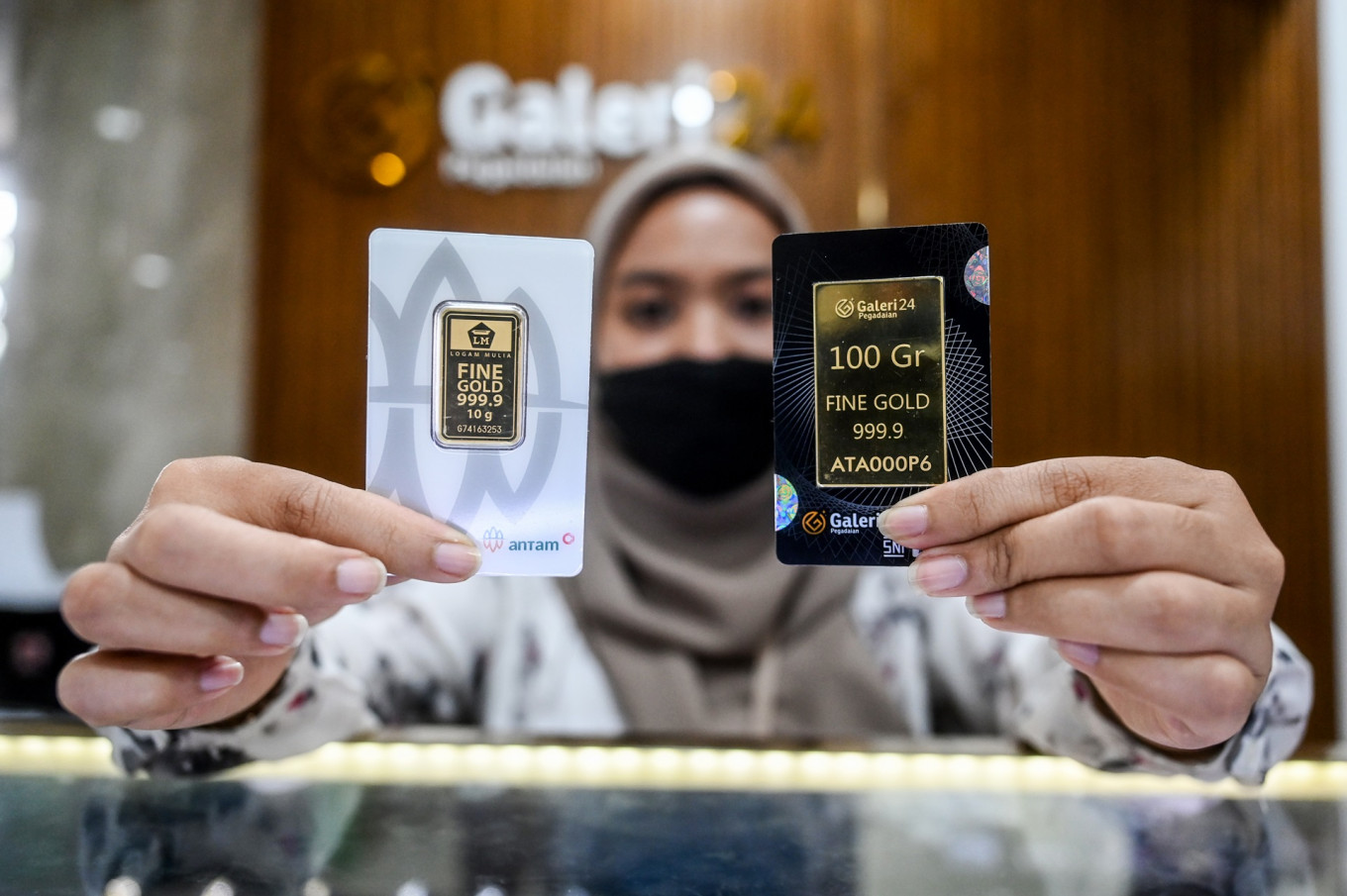
Table of Contents
Introduction
Business – Indonesia, renowned for its abundant natural resources, has long been a significant player in the global gold market. As of February 26, 2025, the Indonesian government has taken a monumental step by launching the country’s first Bullion Bank. This initiative aims to revolutionize the gold industry, enhance economic stability, and offer new financial avenues for both investors and the general populace.
Understanding Bullion Banks

In the intricate world of finance, bullion banks play a pivotal role in the trading, storage, and financing of precious metals, particularly gold and silver. These specialized institutions serve as the backbone of the global bullion market, facilitating transactions that influence economies and individual investors alike. As of February 26, 2025, the dynamics of bullion banks have undergone significant transformations, impacting both the financial sector and society at large.
What Are Bullion Banks?
Bullion banks are financial entities that engage in activities related to precious metals, primarily gold and silver. Their core functions include:
Trading: Buying and selling bullion on behalf of clients or for their own accounts.
Storage and Custody: Providing secure storage solutions for physical precious metals.
Financing: Offering loans secured by bullion or facilitating bullion leasing arrangements.
Hedging and Risk Management: Assisting clients in managing exposure to fluctuations in precious metal prices.
These banks operate within a global network, connecting miners, refiners, manufacturers, investors, and central banks, thereby ensuring liquidity and stability in the precious metals market.
Recent Developments in the Bullion Banking Sector
The bullion banking industry has witnessed notable shifts influenced by geopolitical events, economic policies, and market demands. Key recent developments include:
Shift of Bullion to the U.S.
In early 2025, global bullion banks began transporting significant quantities of gold from Asian trading hubs such as Dubai and Hong Kong to the United States. This movement was driven by the high premium on U.S. gold futures over spot prices, presenting profitable arbitrage opportunities. Traditionally, gold flows from Western markets to meet demand in countries like China and India. However, concerns over potential U.S. import tariffs led to a reversal of this trend, with banks capitalizing on the price differentials. This shift resulted in an 80% increase in COMEX gold inventories, with inflows from various global sources.
Establishment of Bullion Banks in Emerging Markets
Recognizing the strategic importance of precious metals, countries like Indonesia have initiated the establishment of national bullion banks. In January 2025, the Indonesian government announced plans to designate the state-run pawnbroker, PT Pegadaian, as the national bullion bank. This move aims to harness the country’s gold production capabilities, reduce reliance on exports of raw materials, and stimulate local gold mining activities by creating investment channels within the sector.
Impact of Geopolitical Tensions on Gold Movement
Geopolitical uncertainties, particularly potential U.S. import tariffs on precious metals, have prompted bullion banks to adjust their strategies. The anticipation of such tariffs led to a surge in gold shipments to New York, depleting stocks in traditional hubs like London. This reallocation has caused liquidity challenges and increased borrowing costs for gold in markets outside the U.S.
Relevance to Society
The operations and decisions of bullion banks have far-reaching implications for various societal segments:
Investors
Market Opportunities: The recent shifts in gold movement and pricing present both risks and opportunities for investors. Understanding these dynamics is crucial for making informed investment decisions.
Increased Costs: As bullion banks adjust to market changes, costs associated with gold investments, such as leasing rates, may rise, affecting returns for individual and institutional investors.
Consumers
Jewelry Prices: Fluctuations in gold availability and pricing can directly impact the retail cost of gold jewelry, making it more expensive for consumers.
Economic Confidence: Gold is often viewed as a safe-haven asset. Significant changes in the gold market can influence consumer confidence, especially during economic uncertainties.
Local Economies
Job Creation: The establishment of bullion banks in countries like Indonesia is expected to stimulate local mining industries, leading to job creation and economic growth in mining regions.
Infrastructure Development: Investments in bullion banking infrastructure can lead to the development of secure storage facilities and transportation networks, benefiting the broader economy.
Impact of Innovations in Bullion Banking
Innovations and strategic decisions within the bullion banking sector have several notable impacts:
Market Liquidity and Stability
The reallocation of gold reserves to different global hubs affects liquidity in various markets. For instance, the movement of gold to the U.S. has led to increased borrowing costs in London, impacting traders and financial institutions operating there.
Investment Strategies
With changing dynamics in gold premiums and availability, investors may need to reassess their strategies. The potential for higher returns in certain markets might attract more speculative investments, while increased costs in others could deter participation.
Economic Policy and Trade
Government policies, such as proposed import tariffs, can significantly influence the operations of bullion banks. These policies may lead to strategic shifts in gold storage and trading, affecting international trade balances and economic relations.
Bullion banks are integral to the global precious metals market, influencing economic stability, investment opportunities, and societal wealth distribution. Recent developments, including strategic relocations of gold reserves and the establishment of national bullion banks in emerging markets, underscore the dynamic nature of this sector. As these institutions navigate geopolitical challenges and market fluctuations, their decisions will continue to have profound impacts on both the global economy and individual stakeholders.
The Inception of Indonesia’s First Bullion Bank

Indonesia, a nation rich in natural resources, has long been a significant player in the global gold market. However, the country’s gold industry has primarily focused on extraction and export, with limited domestic value addition. Recognizing the potential to harness its gold reserves more effectively, Indonesia is set to inaugurate its first bullion bank on February 26, 2025. This monumental step aims to revolutionize the nation’s gold industry, enhance economic stability, and provide new financial avenues for businesses and the general populace.
Understanding Bullion Banks
A bullion bank is a specialized financial institution that deals primarily with precious metals, notably gold and silver. Its core functions include:
Trading: Facilitating the buying and selling of precious metals.
Storage and Custody: Providing secure storage solutions for physical gold and silver.
Financing: Offering loans secured by precious metals.
Hedging and Risk Management: Assisting clients in managing exposure to price fluctuations in the precious metals market.
By offering these services, bullion banks play a pivotal role in stabilizing and structuring the precious metals market, bridging the gap between producers, consumers, and investors.
The Journey to Establish Indonesia’s First Bullion Bank
The initiative to establish a bullion bank in Indonesia has been a collaborative effort involving various stakeholders:
Governmental Support: The Indonesian government, under the leadership of President Prabowo Subianto, has been instrumental in this endeavor. Recognizing the strategic importance of gold in bolstering economic resilience, the government has provided the necessary regulatory framework and support. In January 2025, the Financial Services Authority (OJK) granted approval to state-owned pawnshop PT Pegadaian to offer bullion services, marking a significant milestone in this journey.
Regulatory Framework: The OJK has been proactive in establishing regulations to govern bullion banking activities. In November 2024, the OJK introduced guidelines aimed at ensuring transparency, security, and efficiency in bullion transactions. These regulations are designed to foster trust among investors and the general public, paving the way for a robust bullion banking system.
Institutional Participation: Beyond PT Pegadaian, other financial institutions have shown interest in participating in the bullion banking sector. Notably, Bank Syariah Indonesia (BSI) has received regulatory approval to operate as a bullion bank, expanding its portfolio to include gold-related financial services.
Relevance to Society
The establishment of Indonesia’s first bullion bank is poised to have far-reaching implications for various segments of society:
Economic Empowerment: By providing avenues for gold-backed financing, the bullion bank can empower small and medium-sized enterprises (SMEs) to access capital more readily. This can stimulate entrepreneurship, leading to job creation and economic diversification.
Financial Inclusion: The bullion bank offers innovative financial products that cater to a broader audience, including those previously unbanked. Gold savings accounts and microloans secured by gold can attract individuals from various economic backgrounds, promoting financial inclusivity.
Investment Opportunities: For individual investors, the bullion bank provides a secure platform to invest in gold, either through physical holdings or financial instruments. This diversification can enhance personal financial security, especially in times of economic uncertainty.
Cultural Significance: Gold holds a special place in Indonesian culture, often associated with wealth and status. The bullion bank can tap into this cultural affinity, encouraging individuals to formalize their gold holdings, which can then be leveraged for economic benefits.
Impact of Innovation
The introduction of a bullion bank in Indonesia brings several innovative impacts:
Enhanced Economic Stability: By monetizing gold reserves, the bullion bank can strengthen the national currency and reduce reliance on foreign exchange reserves. This can lead to a more resilient economy, better equipped to withstand global financial fluctuations.
Promotion of Gold Downstreaming: The bullion bank encourages the processing and utilization of gold within the country, adding value to the raw material before it reaches the market. This downstreaming can lead to the development of related industries, such as jewelry manufacturing and technology sectors that utilize gold.
Digitalization of Gold Assets: Embracing technological advancements, the bullion bank can offer digital platforms for gold transactions, making it convenient for individuals to buy, sell, or pledge gold assets. This digital approach aligns with the global trend towards fintech solutions, appealing to a tech-savvy population.
Strengthening Foreign Exchange Reserves: Analysts suggest that bullion banks can help Indonesia safeguard its foreign exchange reserves amid geopolitical uncertainty, enhancing the stability of its currency and reducing reliance on the US dollar.
Challenges and Considerations
While the prospects are promising, the successful implementation of the bullion bank requires addressing several challenges:
Regulatory Compliance: Ensuring that all operations adhere to national and international regulations is paramount. This includes anti-money laundering (AML) measures, know-your-customer (KYC) protocols, and other financial regulations to maintain the integrity of the banking system.
Public Awareness and Education: Educating the public about the benefits and operations of the bullion bank is crucial. A well-informed populace is more likely to engage with the bank’s services, leading to broader financial inclusion and economic benefits.
Infrastructure Development: Establishing secure and accessible physical and digital infrastructures is essential for the bank’s operations. This includes secure storage facilities for
Implications for the Indonesian Economy

Indonesia, as the largest economy in Southeast Asia, continues to experience significant transformations driven by economic policies, technological advancements, and global market dynamics. In 2025, the country stands at a crucial juncture, with several key developments shaping its economic future. From the impact of digitalization and industrial growth to government strategies in stabilizing inflation and fostering investments, Indonesia’s economy is evolving in ways that will influence businesses, consumers, and international investors alike.
This article explores the current economic trends in Indonesia, their implications for various sectors, and how they will shape the nation’s future. By understanding these factors, individuals and businesses can better navigate opportunities and challenges within the Indonesian economy.
1. Economic Growth in 2025: A Resilient Recovery?
1.1. Post-Pandemic Recovery and Growth Projections
Indonesia’s economy has demonstrated resilience after the COVID-19 pandemic, with the government implementing aggressive recovery measures. The country’s GDP growth rate is expected to reach 5.3% in 2025, following a steady increase in domestic consumption, infrastructure development, and export performance.
The government’s focus on industrialization and foreign investments has contributed to sustained economic expansion.
The rise of the digital economy has accelerated entrepreneurship, fintech adoption, and financial inclusion.
Trade agreements and international partnerships have strengthened Indonesia’s position as a major global player in commodities like nickel, palm oil, and coal.
However, global economic uncertainties, including rising interest rates and geopolitical tensions, pose risks that could slow growth.
2. The Role of Digitalization in Economic Transformation
2.1. The Expanding Digital Economy
Indonesia’s digital economy is projected to surpass $150 billion by 2025, driven by e-commerce, fintech, and artificial intelligence. Key players like Tokopedia, Shopee, and Gojek continue to expand, attracting global investors.
Fintech Growth: Digital banking and fintech services are revolutionizing financial transactions, with a rise in mobile payments, online lending, and cryptocurrency adoption.
E-commerce Boom: The convenience of online shopping is reshaping consumer behavior, with platforms integrating AI-driven recommendations and seamless payment solutions.
AI and Automation: Businesses are adopting AI for better customer engagement, data analytics, and operational efficiency.
Despite its rapid expansion, the digital economy also faces challenges, including cybersecurity threats, data privacy concerns, and regulatory uncertainties.
3. Infrastructure and Industrial Development: A Game Changer?
3.1. New Capital City (IKN) and Economic Expansion
The government’s ambitious Nusantara Capital City (IKN) project, which aims to move Indonesia’s capital from Jakarta to East Kalimantan, is expected to boost regional economies.
Infrastructure investments exceeding $32 billion will create jobs, stimulate property markets, and attract global investors.
Sustainable development focus, incorporating smart city technologies, will position Indonesia as a leader in urban planning.
However, challenges such as land acquisition, environmental concerns, and financing hurdles could impact the project’s success.
3.2. Indonesia as a Global Industrial Hub
Indonesia’s rich natural resources, particularly in nickel, bauxite, and palm oil, have positioned the country as a key supplier for electric vehicle (EV) batteries and renewable energy projects.
Nickel Processing Boom: Indonesia’s dominance in the global nickel supply chain (used in EV batteries) has attracted investments from Tesla, CATL, and LG.
Energy Transition Initiatives: The government’s commitment to reducing carbon emissions by 2060 has accelerated investments in renewable energy projects, such as solar and hydropower.
The industrial sector’s transformation presents significant economic opportunities but also environmental concerns, particularly regarding deforestation and sustainability.
4. Financial Markets and Investment Climate
4.1. Foreign Direct Investment (FDI) Trends
Indonesia has become one of the most attractive investment destinations in Asia. The government’s Omnibus Law on Job Creation has simplified regulations, making it easier for businesses to operate.
Technology and Manufacturing Sectors: The relaxation of foreign ownership laws has boosted FDI in digital startups, e-commerce, and high-tech industries.
Green Investments: Renewable energy and ESG (Environmental, Social, and Governance) initiatives are gaining momentum, attracting impact investors.
However, regulatory uncertainties and political shifts could impact investor confidence in the coming years.
4.2. Strengthening the Banking Sector
The Indonesian banking sector is experiencing rapid modernization, with digital banking, fintech integration, and AI-driven financial services playing a key role.
Bullion Banking Innovations: Indonesia’s first bullion bank (launched in early 2025) aims to monetize the country’s gold reserves, providing new investment opportunities.
Digital Banking Growth: Banks like BRI and BCA are launching fully digital services, catering to the younger generation and increasing financial inclusion.
While digital banking presents opportunities, concerns over cybersecurity, data protection, and fraud prevention remain crucial.
5. Challenges Facing the Indonesian Economy
Despite the optimistic outlook, Indonesia faces several challenges that could impact its long-term growth:
5.1. Inflation and Cost of Living
The rising cost of essential goods, fuel, and housing has raised concerns among the middle class. The government is implementing subsidies and wage adjustments to balance economic stability.
5.2. Workforce Readiness and Education
As the economy shifts towards high-tech industries, education and workforce training need to evolve. The government is investing in STEM (Science, Technology, Engineering, and Mathematics) education, but skill gaps remain a challenge.
5.3. Political and Regulatory Uncertainties
With elections approaching in 2029, economic policies could shift. Investors and businesses must remain vigilant about potential regulatory changes affecting taxation, trade, and foreign investments.
Indonesia’s economic landscape in 2025 is marked by robust growth, digital innovation, industrial expansion, and evolving investment opportunities. The government’s commitment to infrastructure development, financial inclusion, and technological advancements positions Indonesia as a key player in the global economy.
However, addressing inflation, workforce readiness, and regulatory challenges will be crucial for sustaining economic momentum. Businesses and individuals must stay informed and adapt to these evolving economic conditions to seize opportunities in Indonesia’s dynamic marketplace.
Global Context: Indonesia vs. China and India
Despite being one of the world’s top gold producers, Indonesia’s gold reserves have historically lagged behind those of China and India. The launch of the Bullion Bank aims to address this disparity by:
Encouraging Domestic Gold Accumulation: Promoting policies that incentivize the retention of gold within the country.
Facilitating Transparent Gold Transactions: Implementing systems that ensure all gold trades are recorded and regulated, minimizing illicit activities.
Collaborating on International Platforms: Engaging with global gold markets to establish Indonesia as a reputable bullion hub.
By adopting these strategies, Indonesia aspires to elevate its standing in the global gold hierarchy.
Challenges and Considerations
While the prospects are promising, the Bullion Bank’s success hinges on addressing several challenges:
Regulatory Framework: Establishing comprehensive regulations to govern gold transactions and ensure investor protection.
Market Awareness: Educating the public about the benefits and risks associated with gold investments.
Infrastructure Development: Building secure facilities for gold storage and efficient systems for transaction processing.
Global Market Fluctuations: Developing strategies to mitigate the impacts of international gold price volatility on the domestic market.
Conclusion
The inauguration of Indonesia’s first Bullion Bank marks a significant milestone in the nation’s economic journey. By leveraging its rich gold resources, Indonesia is poised to enhance economic stability, offer diversified investment opportunities, and assert its influence in the global bullion market. As the Bullion Bank embarks on its operations, its success will largely depend on strategic planning, robust regulatory frameworks, and active participation from all economic sectors.
Read Also: Key Approaches for Success in the Market










:max_bytes(150000):strip_icc()/Term-Definitions_Digital-Marketing-5ae6ea1aee934b02a94a1a4d9401443d.jpg)




